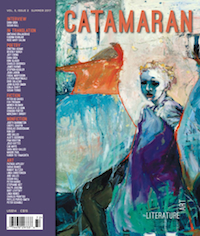
TULPA MAX
OR,
NOTES ON THE AFTERLIFE OF A RESURRECTION
Originally
published in Catamaran
Literary Reader,
summer 2017
(and in Spanish in Letras Libres)
C.M. MAYO
. |
  In
a manner of speaking,
we historical novelists are in the resurrection business. But
who, or rather, what precisely is it that we bring to life? These
characters infused by our imaginations, yet based on beings who
were once flesh, blood, and bone, can they escape the page and,
like the tulpas of Tibetan esoteric tradition, In
a manner of speaking,
we historical novelists are in the resurrection business. But
who, or rather, what precisely is it that we bring to life? These
characters infused by our imaginations, yet based on beings who
were once flesh, blood, and bone, can they escape the page and,
like the tulpas of Tibetan esoteric tradition,  take
on a will of their own and haunt their creators? In the case
of Maximilian von Habsburg, that Archduke of Austria who ended
both his reign as Emperor of Mexico and his life before a firing
squad in Querétaro one hundred fifty years ago, and whom
I made a character in my novel based on the true story of Agustín
de Iturbide y Green, The
Last Prince of the Mexican Empire, I must confess that
yes, he haunts me. take
on a will of their own and haunt their creators? In the case
of Maximilian von Habsburg, that Archduke of Austria who ended
both his reign as Emperor of Mexico and his life before a firing
squad in Querétaro one hundred fifty years ago, and whom
I made a character in my novel based on the true story of Agustín
de Iturbide y Green, The
Last Prince of the Mexican Empire, I must confess that
yes, he haunts me.
To start with, soon after the novel's publication (more years
ago than I would care to count), Tulpa Max, as it were, prompted
a little avalanche of correspondence that continues rumbling
into my email inbox to this day.
.
|
Had I seen the mega alebrije, "Amor
por México, Maximiliano y Carlota"?
Did I believe that Maximilian was a Mason?
What did I think of the legend of Justo Serra, was he really
Maximilian, having escaped that firing squad to make a new life
in El Salvador?
.
|
From another reader, Maruja González,
friend of a friend in San Miguel de Allende, I received, along
with her generous permission to post
it on my blog, a family story about the dessert prepared
for Maximilian on his visit to that city in 1864. It so happened
that Maximilian had stayed in her great great grandparents's
house.
.
|
"...and there they made him
a very solemn banquet with music and soloists, and the all ladies,
their hair coiffured, lamented very much the absence of the empress,
Carlotita, as they were already calling her with affection. All
these ladies of the cream of San Miguel society jostled to outdo
each other in making the most elaborate, brilliant, and exquisite
delicacies. One of my aunts had the honor of preparing some pears
in syrup for the monarch, who turned upside down in praise for
this most wonderful dessert... "
.
|
An email as if from beyond the tomb,
for it literally had to do with a tombstone, came from Jean Pierre
d'Huart, great grand nephew of the officer shot in the head on
the highway near Río Frío in March of 1866. That
officer was a high-ranking member of the delegation that came
to Mexico after the death of Carlota's father, King Leopold of
Belgium, and the assumption to that throne of her brother, Leopold
II (yes, he of Congo infamy). That bandits would so brazenly
attack such a party on that highway—the major artery connecting
Mexico City and Veracruz, gateway to Europe—was at the time
and to this day widely considered, both in Mexico and abroad,
a turning point for Maximilian's reign, a harbinger of its end.
I had it wrong in the novel, my correspondent gently informed
me. The Baron d'Huart murdered near Río Frío was
not Charles, then serving in Mexico with the French Imperial
Army, but his distant cousin, Frédéric Victor.
Attached was a photograph taken in Tintigny, Belgium of the very
tombstone, wreathed in vines and its base tufted with moss.
But the most Edgarallenpoe-esque email to date came from a friend,
Roberto Wallentin, with the Spanish translation by his father,
Dr. Roberto Wallentin, of an Hungarian
newspaper article of 1876 by Dr. Szender Ede. Experts on
the period will recognize Dr. Szender Ede as the individual responsible
for the grotesquely inept embalming of Maximilian's corpse. Dr.
Szender Ede tells us:
.
|
"While I was working on the
embalming, and afterwards as well, many people asked if I could
get for them some of the personal belongings of the deceased.
To my knowledge, during his imprisonment in Querétaro,
through varios different people, he sent all of his personal
belongings to members of his family. The only thing left in his
room was the iron frame of the bed in which he slept. Dr. Rivadeneyra
assured Dr. Basch that the Emperor had promised him that and
so, on good faith, Dr. Basch authorized the "donation"
to him. On the other hand, Dr. Licea (and this was also commented
upon in the Mexican press) made a genuine business with objects
that, according to him, had belonged to Maximilian. I kept some
clippings of Maximilian's hair, and most of those I gave to my
friends in San Luís Potosí."
.
|
More than messages from the depths
of cyberspace, however, Tulpa Max prompts comments, generally
kind ones, but on occasion cutting. As the latter have revealed,
and not entirely to my surprise, many Mexicans are dead-certain
that, for having published a novel that has to do with Maximilian,
its author must be enthralled by both the red-beared charms and
anachronistic political philosophy of that antique aristocrat.
Obviously, such persons have not read my book, in which, closely
following the documented history, Maximilian is capable, as in
his dealings with the young American mother of Agustín
de Iturbide y Green, and in his Black Decree (that anyone found
with a weapon could be summarily executed), not to mention his
reinstating slavery, of dunderheaded heartlessness. True, I bring
as much empathy as I can muster to my portrait of Maximilian,
but empathy—seeing
with the heart—is the novelist's first, best, and most powerful
faculty, and it does not necessarily imply sympathy for that
character's actions or ideas.
There are many ways to buy a yacht; uness your name is J.K. Rowling,
writing a novel is not one of them. By far my richest reward
for having resurrected Maximilian has been the cornucopia of
opportunities for "the feast of reason and the flow of soul."
I quote the English poet Alexander Pope, as I like to think Maximilian
would, to describe tete-a-tetes with readers, fellow writers,
and scholars of that exotic, bloody, labyrinthian and transnational
firecracker of an episode of Mexican history.
So I must thank Tulpa Max for my romp of a tour through Querétaro
with novelist Araceli
Ardón. And also for that lunch in the Zona Rosa with
historians Amparo
Gómez Tepexicuapan and Michael
K. Schuessler where, over eggrolls and sweet-and-sour shrimp,
I think it was, and a minor earthquake in the middle of it all,
we talked about Maximilian's
declarations in Nahuatl and Maximilian's gardener, Wilhelm
Knechtel, and the 1865 visit of the Kickapoos.
Because I knew it would be fascinating fun, I interviewed Mexican
historian Alan Rojas Orzechowski for my blog about his research
on Maximilian's court painter, Santiago Rebull—later
Diego Rivera's professor. On Guadalupe Loaeza's radio program
I chatted with her and Verónica González Laporte
about Maximilian's palace balls, Carlota's madness, and that
unlikely wife of French Marshal Achille Bazaine, Pepita
de la Peña.
And there was one shining moment of an afternoon on the cool
and plant-filled terrace of the Centro de Estudios de Historia
de México in Chimalistac when I chanced to talk with Luis
Reed Torres about one of Maximilian's undeservedly forgotten
generals, Manuel Ramírez de Arellano, who escaped a firing
squad only to die of fever in Italy.
I went to Puebla just for the joy of listening to Margarita
López Cano talk about operas by Bellini and by Verdi
in the time of Maximilian.
Most memorable was an entire afternoon of a lunch with Guillermo
Tovar de Teresa in his old (and assuredly haunted) house in Colonia
Roma—lace tablecloth, and rain pattering on the windows.
I had always wanted to meet the author of that glorious book
about Mexico City, La
ciudad de los palacios (The City of Palaces). We talked
until it grew dark about Maximilian and the Iturbides and Miramón
and the rarest of rare books.
Speaking of rare books, I treasure my autographed copies of the
works of Austrian historian Konrad
Ratz, untill his passing in 2014, a tireless researcher into
the life and government of Maximilian. It was a great honor to
have presented his and Amparo Gómez Tepexicuapan's book,
Los
viajes de Maximiliano en México (Maximilian's
Travels in Mexico) one twinkly night in Chapultepec Castle,
no less.
Tulpa Max, who so loves nothing more than to hear about himself
(even his dessicated corpse with eyes pried from a statue of
the Virgin laid over his orbital sockets, and his legs broken
so as to fit into the box), is standing a little straighter now.
The color has risen to his cheeks and his eyes shine open and
bright like a fox's. He runs a gloved hand down his beard, and
he sniffs what he wishes were a sea breeze. But it's just the
humble perfume of my mug of coffee. No garlic, not yet.
Now if you will excuse me, dear reader, I must check my email.
|
|
C.M. Mayo is the author of The Last Prince
of the Mexican Empire, which was published by Unbridled
Books and named a Library Journal Best Book of 2009. It was published
in Spanish, translated by Agustín Cadena, by Random House
Mondadori-Grijalbo in 2010, as El
último príncipe del Imperio Mexicano. |
 |



